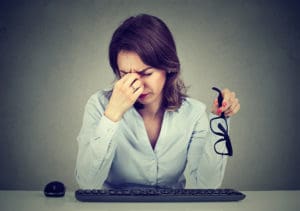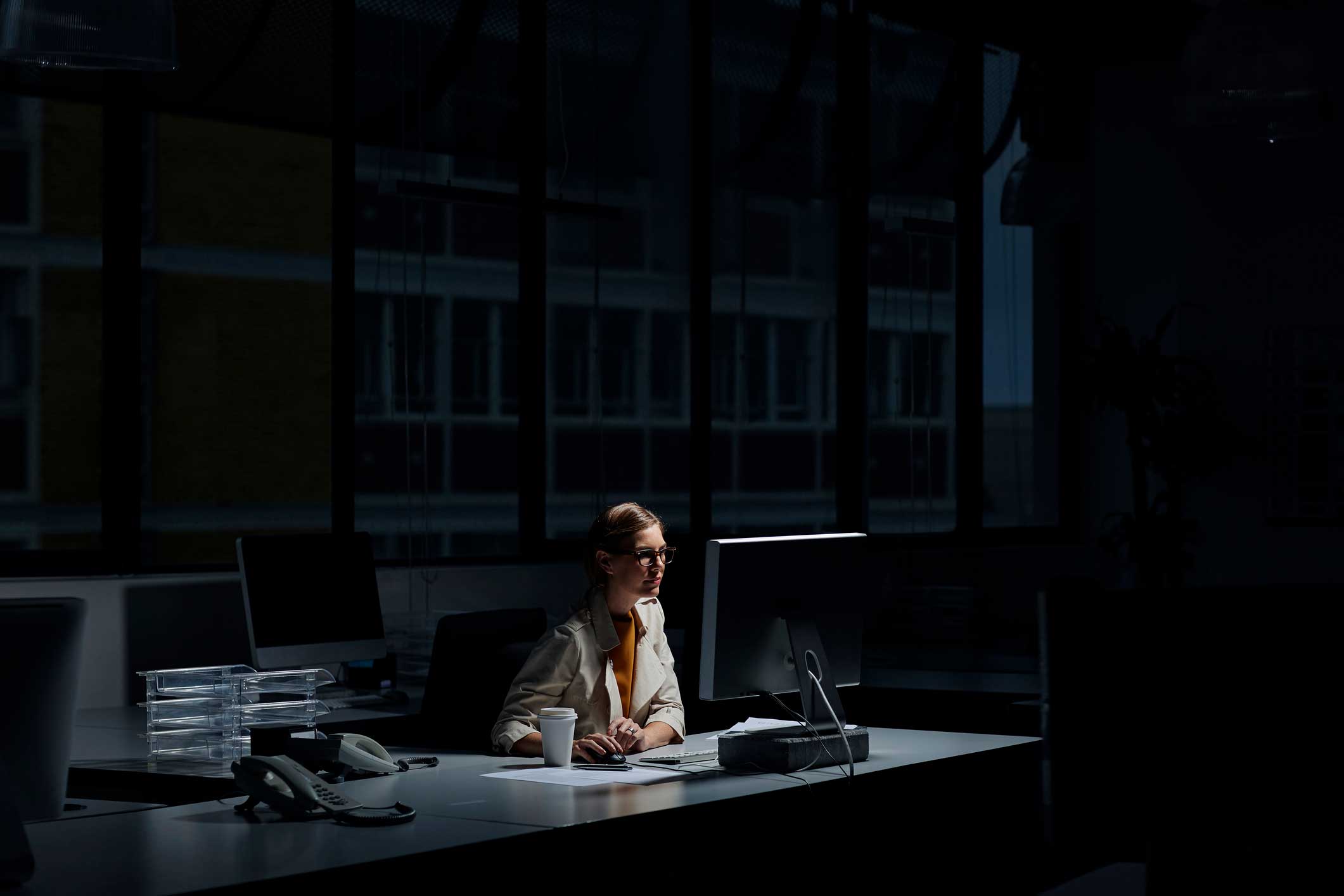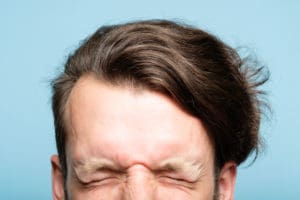Tired Eyes: Symptoms, Causes & Treatments
Home / Eye Health and Preventive Care /
Last Updated:
The human body is not built to sustain infinite strain and exertion without resting, and eyes are no different. If you are experiencing regular eye fatigue, here is our list of possible causes and what you might be able to do about it.
At the bottom line, though, the answer to the question “what causes my eye fatigue?” is likely to be “something you do for work,” and thus unavoidable – unless it’s so bad that it calls for a major career change. The best treatment for tired eyes is going to inevitably be “get more rest.”
Table of Contents

Tired Eyes: The Basics
If you’ve spent prolonged amounts of time viewing any sort of screen, it’s likely that you’ve experienced tired eyes, properly called “ocular fatigue.”
Tired eyes can be classified in a clinical sense as asthenopia (otherwise known as common eye strain). Asthenopia can be caused by prolonged online viewing, driving for long periods of time, lack of sleep, bad eyeglass prescriptions, and general fatigue.
You deserve clear vision. We can help.
With 135+ locations and over 2.5 million procedures performed, our board-certified eye surgeons deliver results you can trust. Your journey to better vision starts here.
With the advent of our digitally-driven world, more and more individuals are experiencing ocular fatigue. Looking at digital device screens with high screen brightness for long periods of time, reading without breaks, and long-distance driving are the most common causes of ocular fatigue and tired eyes.

Causes of Eye Fatigue
When we say that eye fatigue is usually caused by work habits such as screen usage, reading, or driving, we have just described almost the entirety of a typical white collar worker’s day. We wake up and check our social media on a phone, drive to work, spend all day reading and using computer screens, drive home, then spend our remaining leisure hours watching streaming video, playing video games, or more reading.
It’s inevitable that eye fatigue would be a common complaint, because 21st century life is almost continuously demanding on our eyesight every minute of the day.
Screen Time
Too much screen time has its own term: it’s called “digital eye strain.” Staring at a screen puts a burden on the muscles that give the eye the ability to focus. When we look at digital screens, we tend to blink less, which results in faster disruption and evaporation of the film of tears. These tears serve as a protective surface for the eye.
Long-Distance Driving
Driving for long distances and long periods of time also puts a high amount of strain on the eyes. Driving might seem like an activity that doesn’t require a lot of energy, but driving brings on its own special kind of fatigue. People who drive for a living (truck deliveries, Uber drivers, etc.) are the most at risk.
While driving, most individuals tend to have intense focus as they observe traffic. The eyes track movement constantly in addition to having to read road signage. Because of this, driving for long distances is a common contributor to eye strain.
Sustained Reading
Usually this applies to small print. Reading a hardcover book generally doesn’t produce eye strain since the print is large enough to focus on, and books, unlike digital screens, do not glow. However, even reading books for eight hours a day could produce some fatigue.
Instead, think more of lawyers, paralegals, and others who have to pore over pages of documents in boilerplate legalese. Reading fine print is a consistent cause of eye strain.
Why Do My Eyes Feel Heavy?
The sensation of heavy eyes often goes hand in hand with tired eyes and is one of the subjective feelings of eye fatigue. If you’ve ever wondered, “Why do my eyes feel heavy?” the reasons are closely related to the causes of tired eyes mentioned above.
Heavy eyes are typically a result of the muscles in and around the eyes being overworked. When engaged in prolonged activities such as extended screen time, long-distance driving, or sustained reading, the eye muscles become fatigued, leading to that heavy sensation. This is similar to the way your leg muscles might feel after a strenuous hike or run.
Other factors that might contribute to heavy eyes include lack of sleep, dehydration, and underlying medical conditions such as allergies. The symptoms of heavy eyes may also present themselves alongside other symptoms of eye strain, like dryness, irritation, and difficulty focusing.
Ciliary & Extraocular Muscles
The eye makes use of a variety of muscles that all come into play when helping the eye focus on objects. These muscles need to be engaged and also need to rest when applicable.
The pupils of the eye are moved by ciliary muscles. These muscles have a way of constricting that promotes proper up-close vision. These muscles are also responsible for dilating the pupil, which promotes focusing on objects that are farther away.
When the eye moves back and forth quickly, the eye’s extraocular muscles are responsible for this sort of movement. Moving the eyes from side to side can certainly cause the eye muscles to become stressed and overworked, especially if focusing on an object that is small, an object on a screen, or an object located in a dark environment.
Tired Eyes Symptoms – A Checklist
Eye fatigue may present with a host of other symptoms, especially affecting vision.
- Sore eyes
- Eye irritation
- Inability to focus on objects
- Dry eyes
- Watery eyes
- Blurred vision
- Dizziness
- Difficulty with concentration
- Double vision
- Light sensitivity
- Body pain, particularly in the neck, shoulders, and back
- Slowed rate of productivity

You deserve clear vision. We can help.
With 135+ locations and over 2.5 million procedures performed, our board-certified eye surgeons deliver results you can trust. Your journey to better vision starts here.
Diagnosis of Eye Fatigue
Tired eyes are fairly trivial to self-diagnose. If symptoms are only appearing when you engage in a certain activity or are in a certain environment, that tells you where the trouble is. If you find yourself having frequent ocular fatigue, it may be time to visit with an eye specialist.
Any lingering problems or more intense symptoms like nausea, extreme dizziness, or pain may suggest the presence of a vision deficit. Such symptoms can also be the result of a more severe case of asthenopia. Severe cases of asthenopia may require lifestyle changes or a doctor’s intervention.
If you visit a doctor for eye fatigue, the doctor will likely have you undergo an eye exam. Your optometrist will determine the condition of your eyes and also be able to diagnose any vision problems. They will help you home in on what corrective measures should be taken to rectify the situation.

Treatment for Tired Eyes
The only recommended treatment for eye fatigue is to stop doing the activity causing the fatigue, at least long enough to take a break. There is no known permanent cure, at least not for the way we do things now. It is conceivable that at some point in the future, digital devices will come with features built in that are eye-friendly, but that’s a minor improvement to expect at best.
There is one possible suggestion which could help a lot with eye fatigue in the future, and it comes from an unexpected place…
Artificial Intelligence to the Rescue?
Admittedly, Artificial Intelligence (AI) is still in its pioneer days and is currently experiencing an enormous wave of over-hype and over-promise. But there are areas where AI has a proven track record in doing the same things that we do when we experience eye fatigue. If you have work-related eye strain, you might consider investigating one of these technologies to provide a partial solution.
AI Driving: While driverless cars are not quite a reality today, they are an area of much keen interest. After all, traffic accidents still claim tens of thousands of lives every year, so if we as a society can mitigate that danger with AI driving systems, so much the better. In the meantime, AI-assisted driving could be helpful. AI-assisted driving uses the vehicle’s autonomous system as a sort of co-pilot, requiring less vigilant human attention to the road, and less eye strain.
Text-to-Speech Software: Even before the modern AI hype wave, text-to-speech technology was already robust. Instead of having to focus on reading, you can have an AI voice assistant do that for you. Technology has recently advanced in this area, producing expressive human-like voices that are pleasant to listen to, and can reliably read through text with minimal glitches, even allowing for adjustable reading speeds. Next time you have a wall of text to read, consider saving your eyes and have the robot do it for you!
Text Summary AI: We have also had automated document processing software for several years. In this case, the software can plow through an 80-page contract and summarize its key points in a few paragraphs. Like text-to-speech software, AI summarizing tools are already quite prevalent. While there might be some cases where you need to scrutinize every word of a document, AI summaries can wipe out a lot of repetitive reading and shrink it down to a few sentences when you only need a brief skim of the content.
Anything else you can think of to reduce the workload on your eyes should be a consideration. For instance, you might replace some of your leisure reading with audiobooks, or substitute listening to podcasts or other audio-based entertainment for watching streaming video.
Prevention of Eye Fatigue
Without turning to new technology solutions, currently experts recommend these simple tips for reducing eye fatigue…
- Reducing screen time – Even if work requires you to be on a screen, you might want to avoid staring at more screens in your off time, substituting other activities.
- Take breaks – A simple ten minute break every hour or so can cut down tremendously on fatigue when using screens.
- Adjust computer options – You can change your computer’s default font size so text is bigger and easier to focus on. You can use “night mode” settings and app themes which reduce eye strain. You should also check the settings in your phone and operating system, to see if there are settings to reduce blue light radiation.
- Adjust work lighting conditions – Lighting that is too dim, as well as bright, glaring lighting, can both be culprits in inducing eye fatigue. Try experimenting with different light levels to see if you find a more soothing option.
A Long-Term Plan
While we all have more demand put on our eyeballs than any other time in history, most people under normal conditions do not experience severe eye fatigue in the course of an eight-hour day. If you aren’t just glued to a screen 24/7 and yet still experience eye fatigue, this may be signs of a serious problem.
If you experience chronic eye fatigue without undue lifestyle causes, this is a reason to seek medical attention. There may be a telltale sign of a debilitating vision problem present, which an eye doctor can nip in the bud. Or you might have other underlying conditions which contribute. Only a doctor at that point can tell.
You deserve clear vision. We can help.
With 135+ locations and over 2.5 million procedures performed, our board-certified eye surgeons deliver results you can trust. Your journey to better vision starts here.
References
- Effects of Paradigm Color and Screen Brightness on Visual Fatigue in Light Environment of Night Based on Eye Tracker and EEG Acquisition Equipment. (May 2022). Sensors.
- Detecting Soldiers’ Fatigue Using Eye-Tracking Glasses: Practical Field Applications and Research Opportunities. (November 2022). Military Medicine.
- Good Work Habits Can Protect Radiologists’ Eyes From Strain. (June 2022). Radiological Society of North America.
- Digital Eye Strain: Prevalence, Measurement and Amelioration. (April 2018). BMJ Open Ophthalmology.
- Correlation Between Eye Movements and Asthenopia: A Prospective Observational Study. (November 2022). Journal of Clinical Medicine.
- Anatomy, Head and Neck, Eye Muscles. (August 2022). StatPearls.
- Digital Eye Strain- A Comprehensive Review. (July 2022). Ophthalmology and Therapy.
- Doctor, My Eyes… Are Tired! (May 2016). Review of Optometry.
This content is for informational purposes only. It may have been reviewed by a licensed physician, but is not intended to serve as a substitute for professional medical advice. Always consult your healthcare provider with any health concerns. For more, read our Privacy Policy and Editorial Policy.